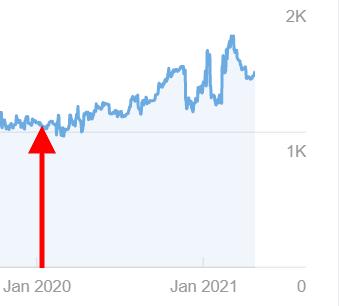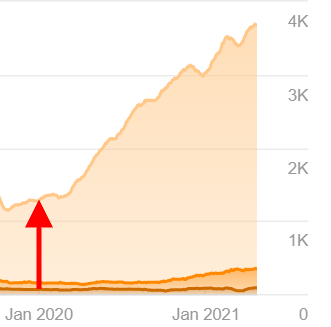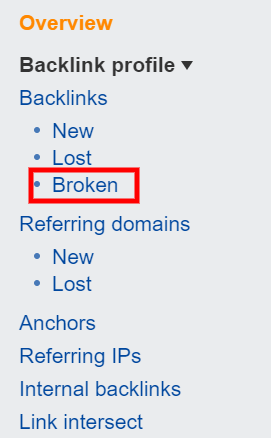How to gain value from broken backlinks
A guide to reaping the benefits of broken backlinks — both yours and your competitors’.
Fortunately, there are some highly effective link-building tactics that give marketers more control and serve both users and website owners. These strategies rely specifically on broken backlinks.
What are broken backlinks?
Much like broken internal links on sites that bring up 4xx client codes, broken backlinks occur when an external link from a site points to a non-existent page on another domain. This most commonly occurs when a page URL has changed or the linking site added an incorrect URL.
In fact, internet professionals have known about the tendency for links/pages to become non-existent for a long time. This phenomenon is often termed “link rot,” and many sites suffer from it. A study conducted by WooRank found that 12.2% of e-commerce site backlinks pointed users to a 404 page.

Though the study only focused on e-commerce sites, there’s a high chance that similar trends would be found in other industries. In fact, we see this played out in the scholarly realm. A study conducted by Harvard Law Review in 2014 found that up to 20% of backlinks may be dead after just one year, and the percentage increases as time goes on.

If the rate of link rot shocks you, you’re not alone. The exponential rate at which backlinks break leaves a tremendous amount of link equity going to waste.
Given the prevalence of such links, it may be surprising to see how infrequently these tactics are discussed among seasoned marketers. This may be due to a disproportionate focus on the largely misunderstood “freshness” factor, opting to focus solely on earning links from new content without reviewing the missed opportunities from “older” backlinks.
However, old backlinks can still be valuable. Marketers can find a treasure trove of value through link reclamation and outreach efforts. All it requires is close attention to the broken links pointing both to your site and your competitors’ sites.
Broken Links: Reclamation vs. Building
There are two important differences between broken link reclamation and broken link building. Link reclamation seeks to literally reclaim the value of broken links pointing to your site. Broken link building, on the other hand, is the process by which you recreate content to replace your competitors’ broken backlinks.
The methods are slightly different, but both grant you more control than standard link-building outreach tasks. They also make a world of difference if properly implemented.
One particularly successful broken backlink project involved my client Ultimate Whale Watch & Snorkel. After initiating reclamation and outreach efforts, the levels of organic traffic and ranked keywords (the images below) increased over the next year at much higher rates than in recent years.


An important thing to note here is the client’s industry. Despite being in the tourism/travel sector during the COVID-19 pandemic, UWW saw a 171.2% increase in organic traffic and a 257.2% increase in organic keywords ranked year over year.
Coupled with the other link-building tools in your belt, broken link reclamation and building efforts can prove incredibly fruitful. Here are our recommended steps for both processes:
Broken backlink reclamation
Step 1: Analyze your site’s backlinks. First, you’ll need to determine how many (if any) backlinks pointing to your site are broken. Ahrefs is a great tool that analyzes this data, it allows you to review which backlinks are pointing to dead links.
Open and log in to Ahrefs, then perform an analysis on your domain.

Step 2: Organize your broken backlinks. Navigate to the “Broken Links” icon under “Backlinks” in the left-hand menu and click it. You’ll then see a list of all the broken backlinks for the site.

It’s helpful to organize the broken backlinks in this list via the “DR” (domain rating) column. This will place the highest-valued links at the top of the list. You can then export these into a spreadsheet for further review.
Step 3: Choose the broken links to go after. This handy table of data will show where the backlink originates from, its anchor text and what URL it is pointing to. Analyze the external domains listed and decide if the backlink is worth pursuing. You may decide some of them are irrelevant, low authority or just pure spam. It’s best to look for backlinks originating from authoritative sites that employ relevant anchor text.
Step 4: Regain the broken link value. Once you’ve put together a list of broken backlinks you’d like to reclaim, review your own site and determine what link would be the most ideal replacement.
There are two main ways to proceed from here.
- Option A: Reach out to the site owner of said backlink and let them know that it is broken. Provide them with the relevant replacement link and ask them to update it. Ideally, the site manager will be happy you pointed out a broken link on their site and add in the live URL.
- Option B: Sometimes the site owner doesn’t respond. In this instance, you can easily regain the lost link value through a redirect. Set up a 301 (permanent) redirect to a relevant page on your site. This way you’ll regain the lost link value and users will arrive on a live page.
Are 301 redirects effective with broken backlinks? Marketers have long debated the exact amount of link equity (or PageRank) that is passed along via 301 redirects. This is largely due to confusion over the way Google and other large search engines treat them.
To clarify this issue, Google’s John Mueller explained how their search engine specifically uses 301 redirects as directives toward canonical URLs. So if the redirect link you set in place isn’t similar enough in topic to the original, Google will likely treat the broken link as a soft 404. But a highly relevant redirect will likely receive close to 100% of the ranking benefits.
This is why it’s so important to make sure the redirect is appropriate to the missing content. You want search engines to treat your redirected URL as canon.
Broken link building using competitor data
Step 1: Analyze your competitor’s backlinks. Choose a competitor and analyze them in Ahrefs in the same manner as described above.
Step 2: Find the relevant broken backlinks. Categorize the broken backlinks by relevance. Review your own site and determine if you have content similar to the topic of the link in question. This will be the broken link you’ll be seeking to replace on the third-party site.
Step 3: Provide the perfect replacement content. Now it’s time to get a piece of relevant replacement content together. If you’re starting from scratch, review the topic of the linking site — and the anchor text — and use it as a springboard for your new page. If the content already exists, then you’re ready to reach out!
Step 4: Reach out to the site owner. Once you have a replacement page ready, reach out to the site owner with the broken link and let them know about the issue. Offer your article as a replacement while doing your best to show how it fits with the content’s topic. You’ll be surprised at how many site owners take you up on this — no one wants to feature articles with errors.
Pay attention to broken backlinks
The broken backlink issues that affect virtually all sites at some point or another offer marketers creative link-building opportunities. Paying attention to these potential links could make a huge difference in your campaigns.



